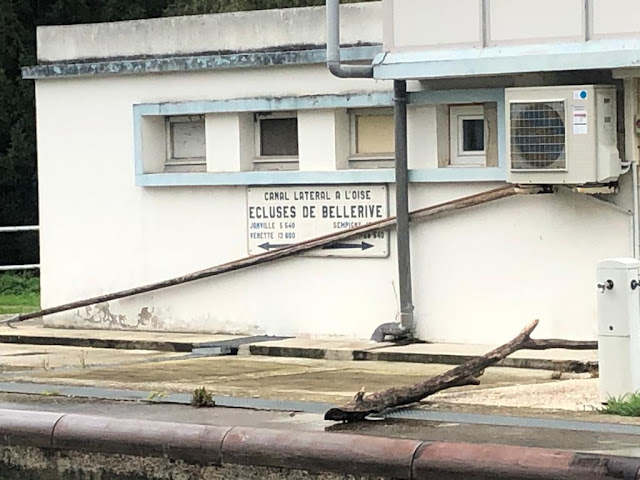This canal links the Canal de Saint-Quentin at Chauny with the River Oise at Janville. On its way it has a junction with the Canal du Nord at Pont-l'Évêque.
The two locks (numbers 3 & 4) on the section between Pont-l'Évêque down to the River Oise have dimensions of 185m x 12m to cater for the larger boats that journey up and down the Canal du Nord. These two locks also have smaller (38.5m x 5.6m) locks alongside to ease the traffic flow especially when the boats are less than 39 metre in length.
The two other locks (numbers 1 & 2) that on the section up to the Canal de Saint-Quentin have dimensions of 38.5m x 5.6m. All the locks are operated by calling the éclusiers on VHF radio. The éclusiers operate the locks from within their control towers.
The following is based on information on frenchwaterways.com:
The Canal Latéral à l’Oise extends the navigable River Oise from Janville to connect with the Canal de Saint-Quentin at Chauny, a distance of 34km.
The navigable River Oise travels for 104km from Janville down to its confluence with the Seine at Conflans-Sainte-Honorine (Fin d’Oise); the overall route is therefore 138km long, and forms part of the important waterway route from the Seine to Northern France, Belgium and the Rhine.
Junctions are made with the Canal de l’Oise à l’Aisne (PK 3) and with the Canal du Nord (PK 18.6). Forming part of the busy ‘north-south’ route between the Seine basin and northern France and Belgium, the canal has seen large-scale improvement works, like the Oise further downstream. The lower section from the junction with the Canal du Nord is to be further widened or rebuilt on a parallel path as part of the Seine-Nord Europe Canal.
History – The river was navigated from the Middle Ages, but canalisation started only in 1835, with locks 41 by 6m or 46 by 8m. In 1910, a new set of locks 125 by 12m were built, with limited depth. Starting in 1965, after the deeper Canal du Nord was opened, new locks 185 by 12m were built, with a sill depth of 4m. Dredging in the river was not consistent throughout, and to prepare for the future Seine-Nord Europe Canal, all the weirs are being replaced, and a depth of 3.50m is to be provided throughout. The canal latéral was built in 1831 to provide a complete itinerary between the Canal de Saint-Quentin and the Seine, and to avoid the winding course of the river Oise in this section.
The two other locks (numbers 1 & 2) that on the section up to the Canal de Saint-Quentin have dimensions of 38.5m x 5.6m. All the locks are operated by calling the éclusiers on VHF radio. The éclusiers operate the locks from within their control towers.
The following is based on information on frenchwaterways.com:
The Canal Latéral à l’Oise extends the navigable River Oise from Janville to connect with the Canal de Saint-Quentin at Chauny, a distance of 34km.
The navigable River Oise travels for 104km from Janville down to its confluence with the Seine at Conflans-Sainte-Honorine (Fin d’Oise); the overall route is therefore 138km long, and forms part of the important waterway route from the Seine to Northern France, Belgium and the Rhine.
Junctions are made with the Canal de l’Oise à l’Aisne (PK 3) and with the Canal du Nord (PK 18.6). Forming part of the busy ‘north-south’ route between the Seine basin and northern France and Belgium, the canal has seen large-scale improvement works, like the Oise further downstream. The lower section from the junction with the Canal du Nord is to be further widened or rebuilt on a parallel path as part of the Seine-Nord Europe Canal.
History – The river was navigated from the Middle Ages, but canalisation started only in 1835, with locks 41 by 6m or 46 by 8m. In 1910, a new set of locks 125 by 12m were built, with limited depth. Starting in 1965, after the deeper Canal du Nord was opened, new locks 185 by 12m were built, with a sill depth of 4m. Dredging in the river was not consistent throughout, and to prepare for the future Seine-Nord Europe Canal, all the weirs are being replaced, and a depth of 3.50m is to be provided throughout. The canal latéral was built in 1831 to provide a complete itinerary between the Canal de Saint-Quentin and the Seine, and to avoid the winding course of the river Oise in this section.
Écluse 3 Bellerive (2.98m)
Écluse 4 Janville (3.33m)


















No comments:
Post a Comment